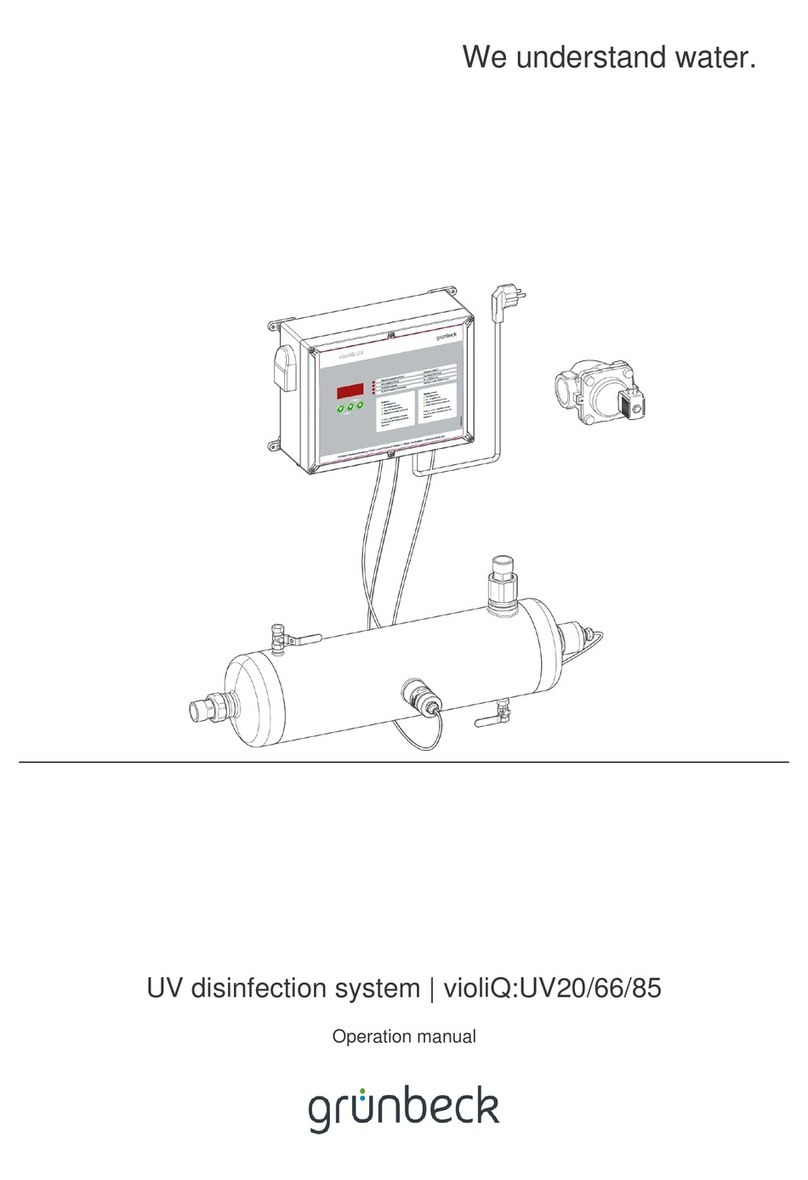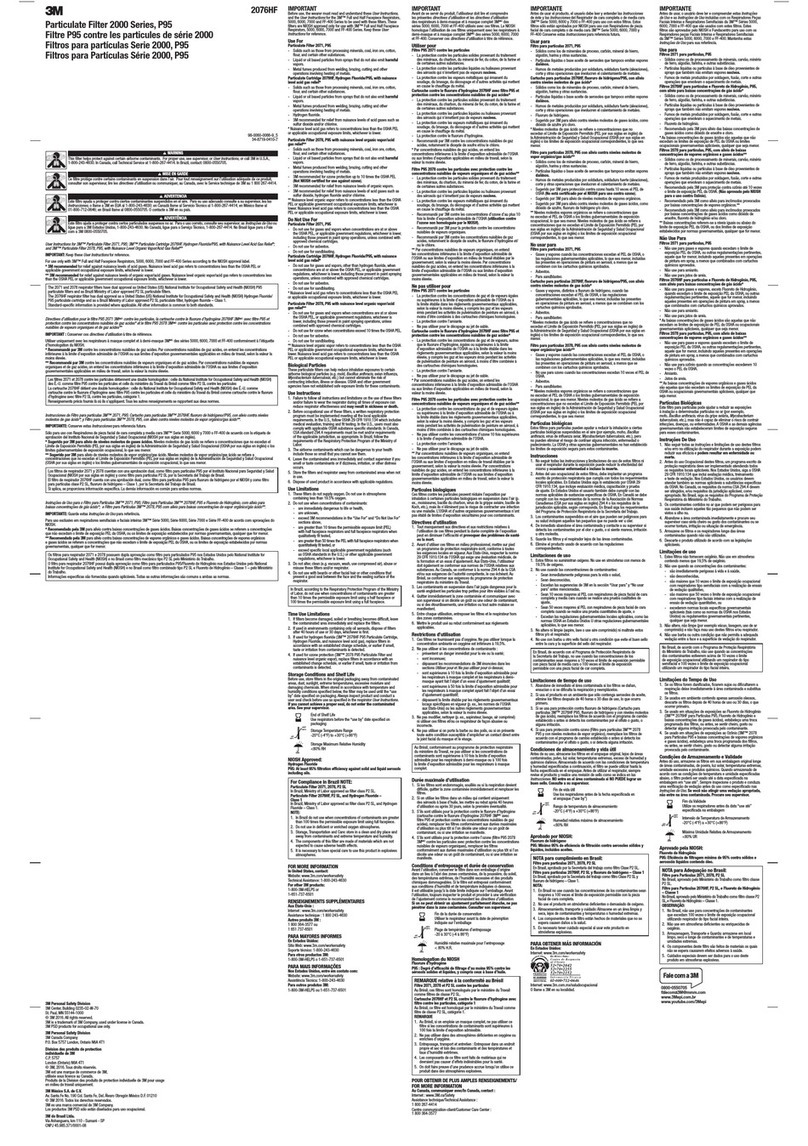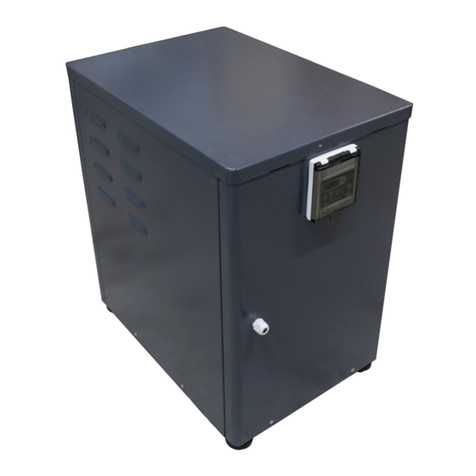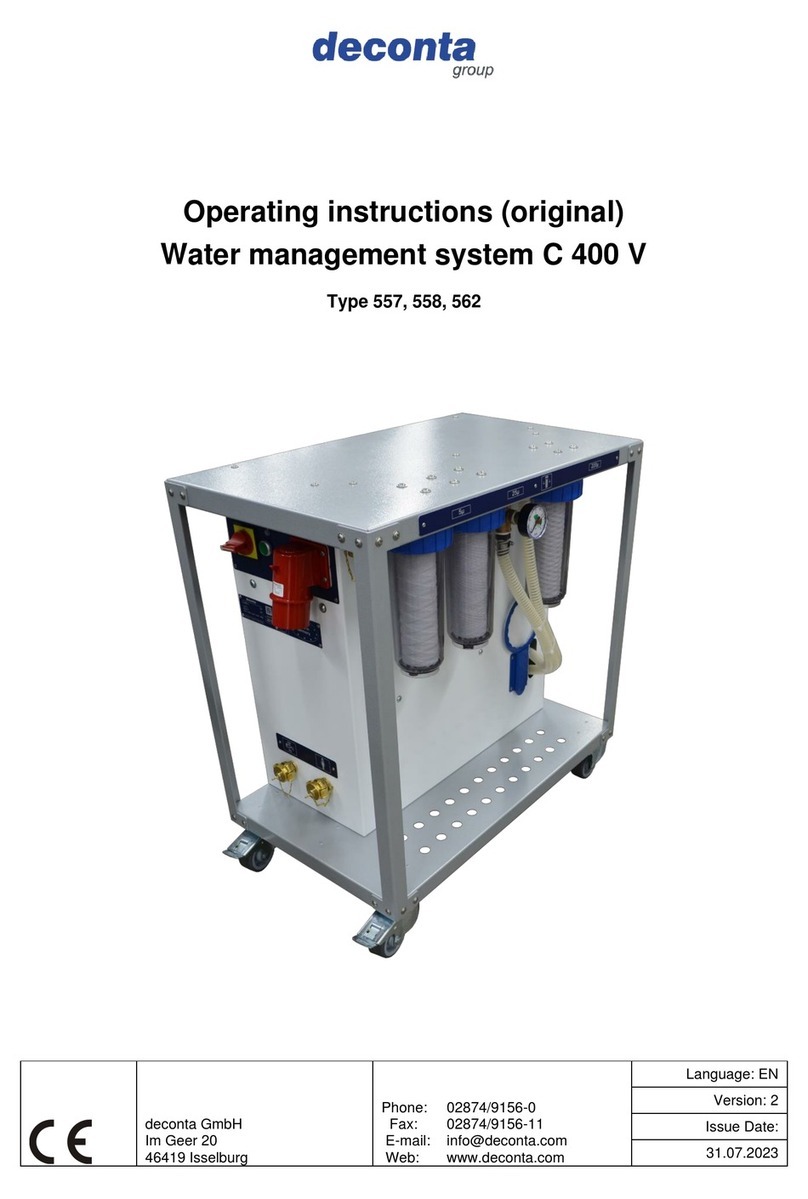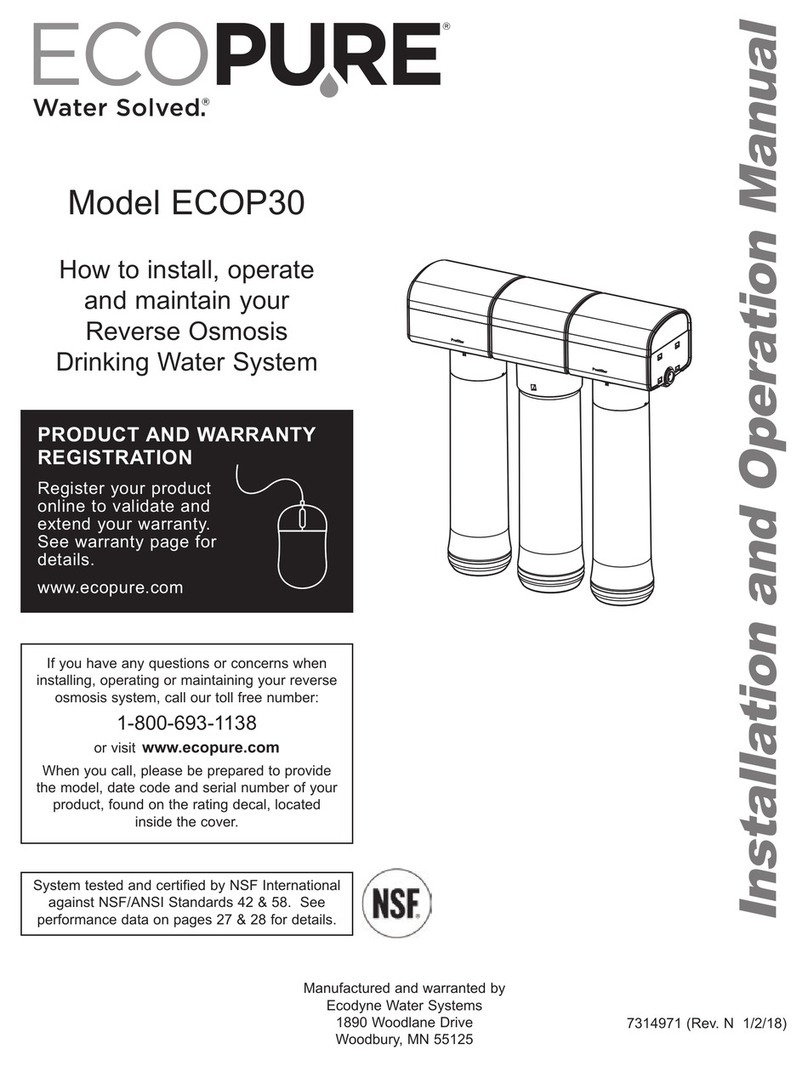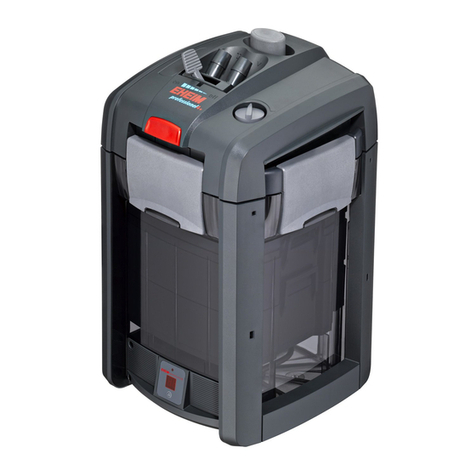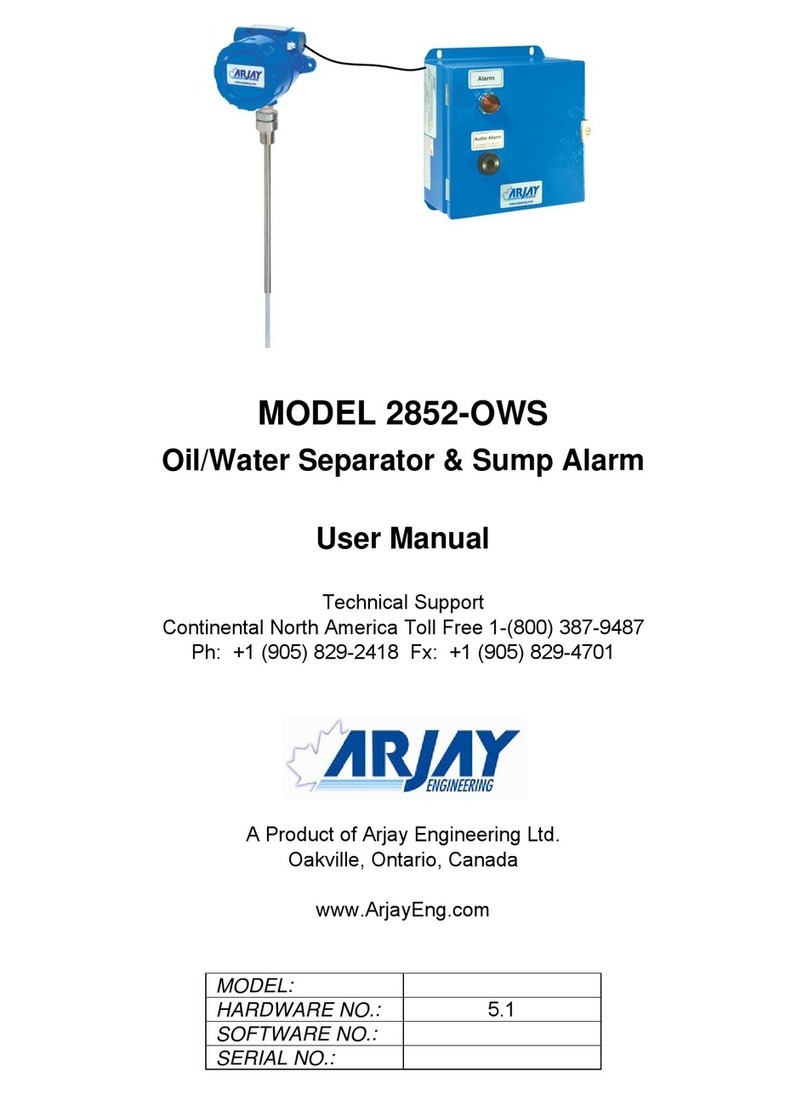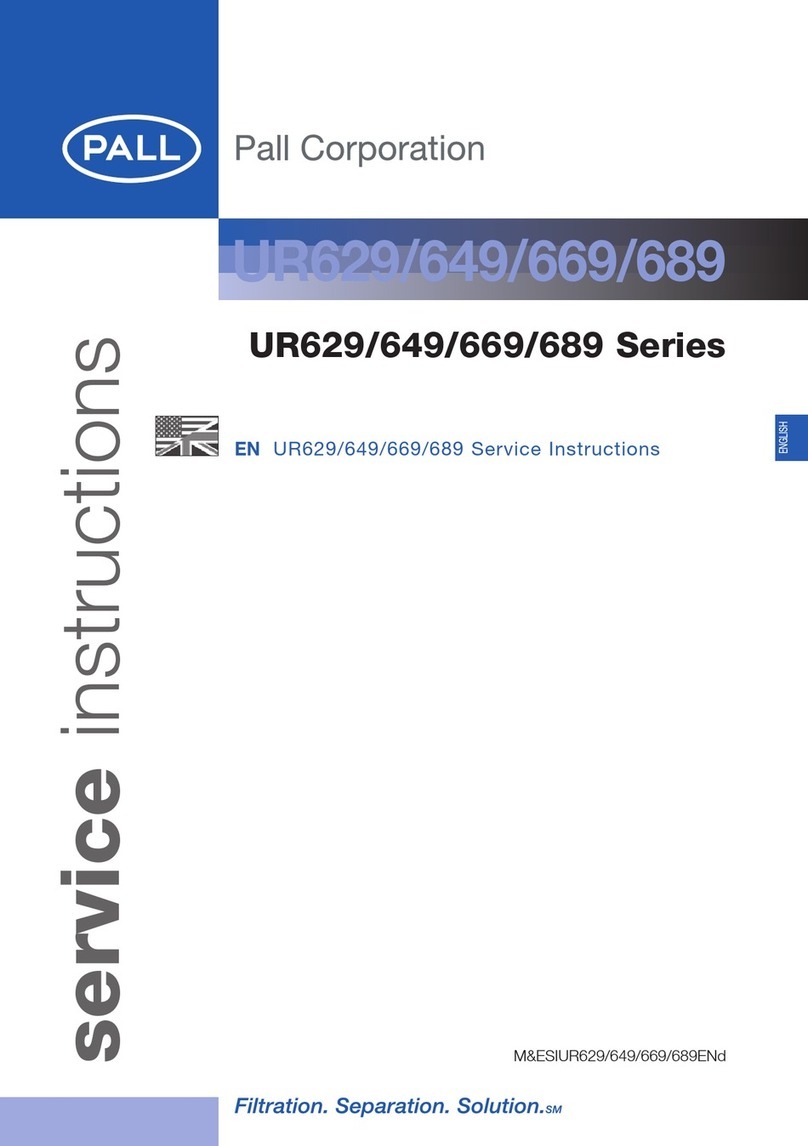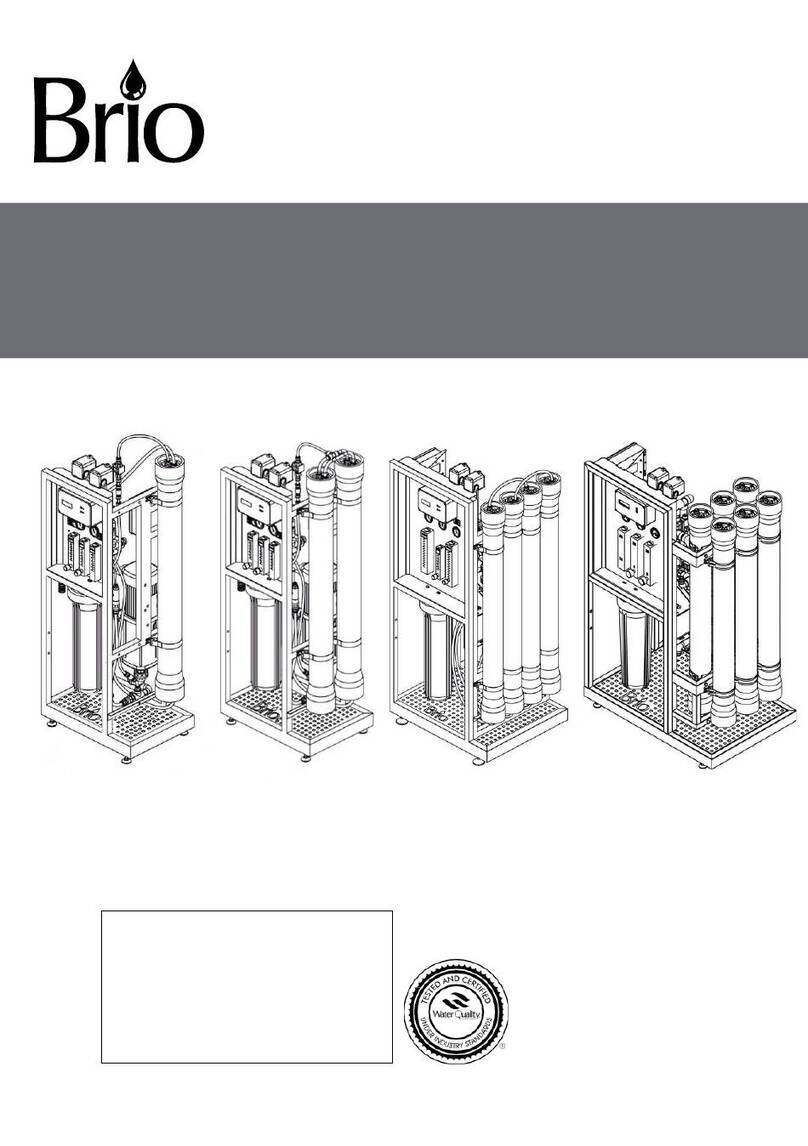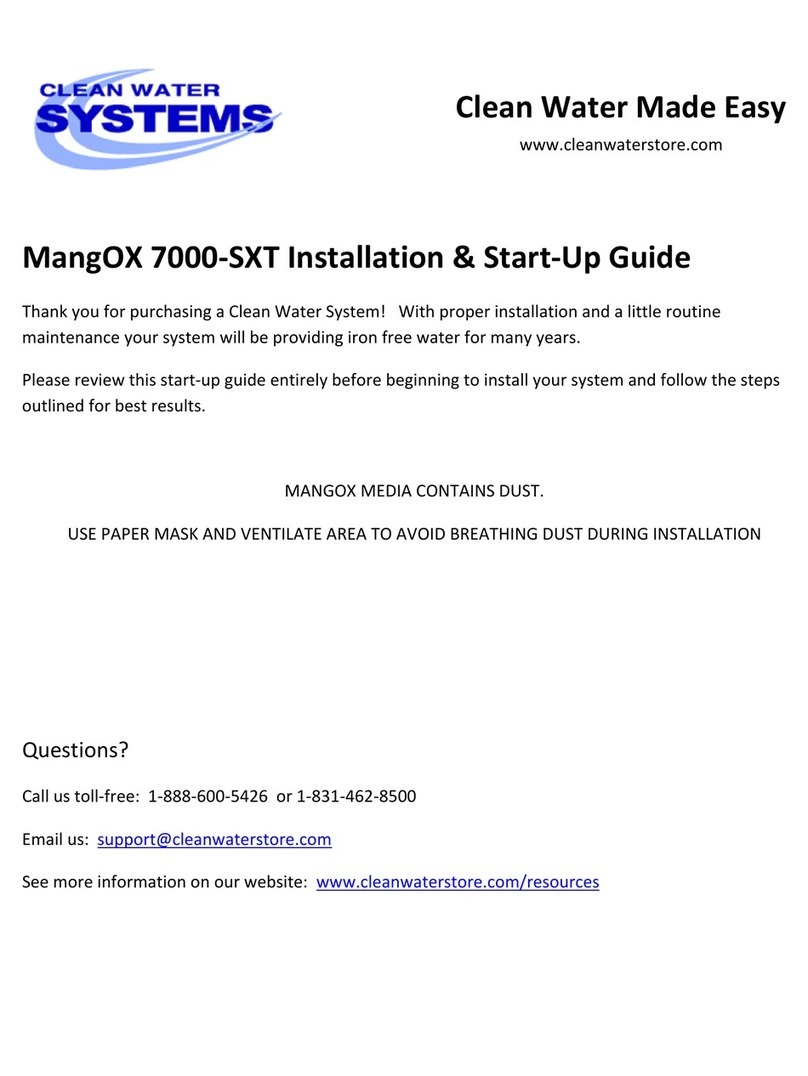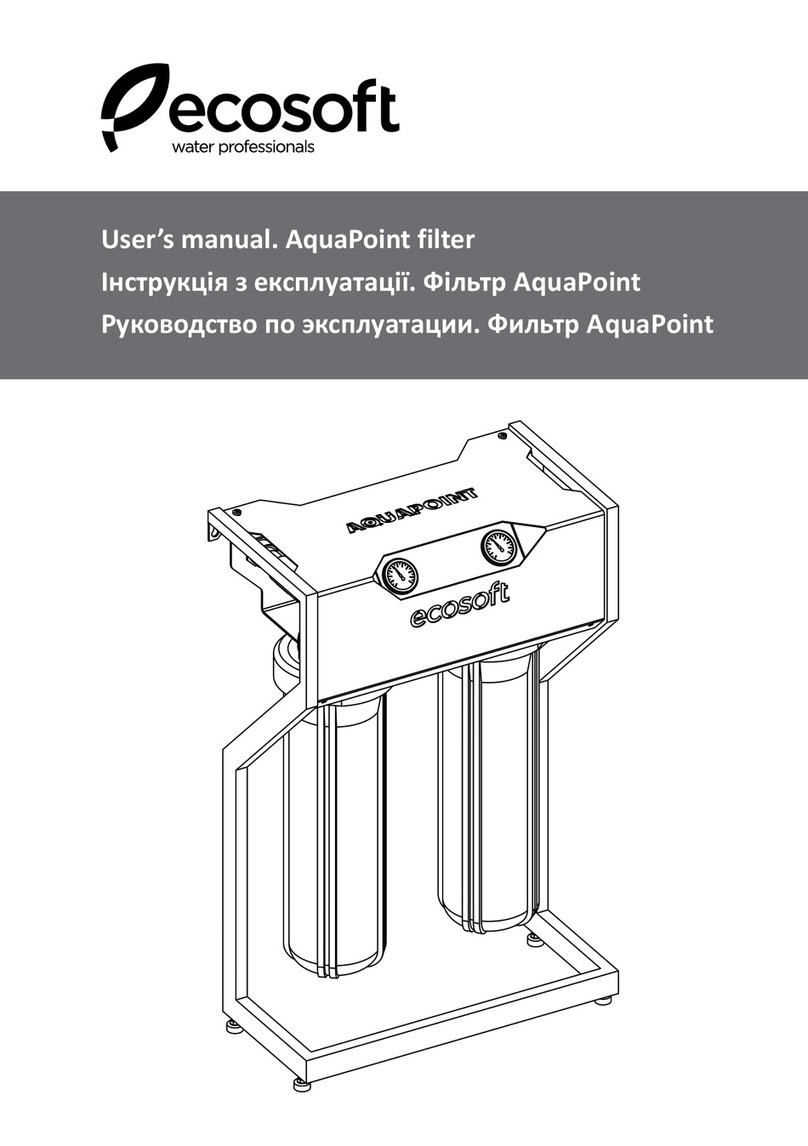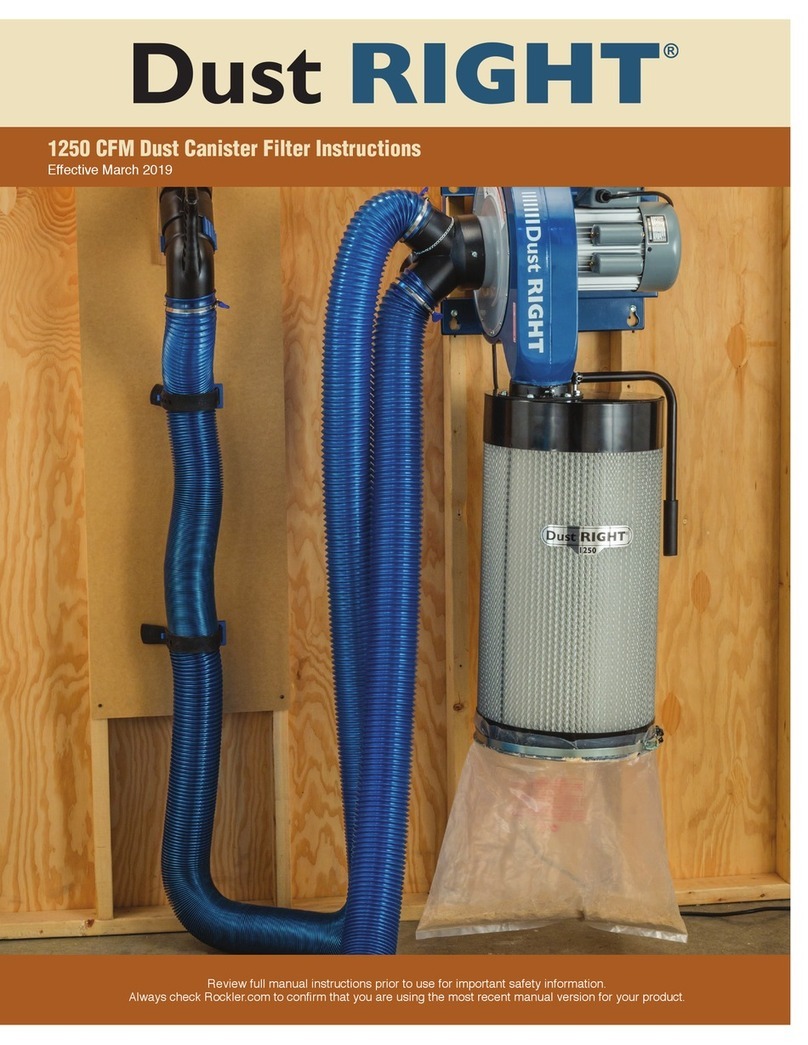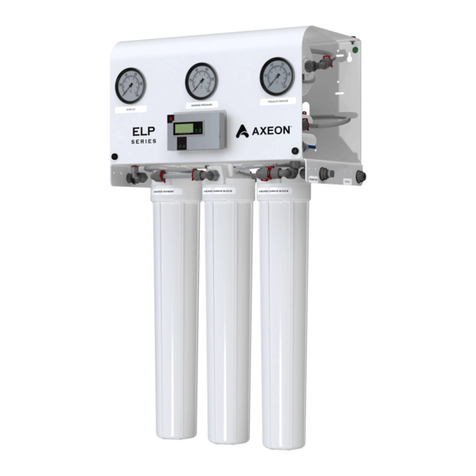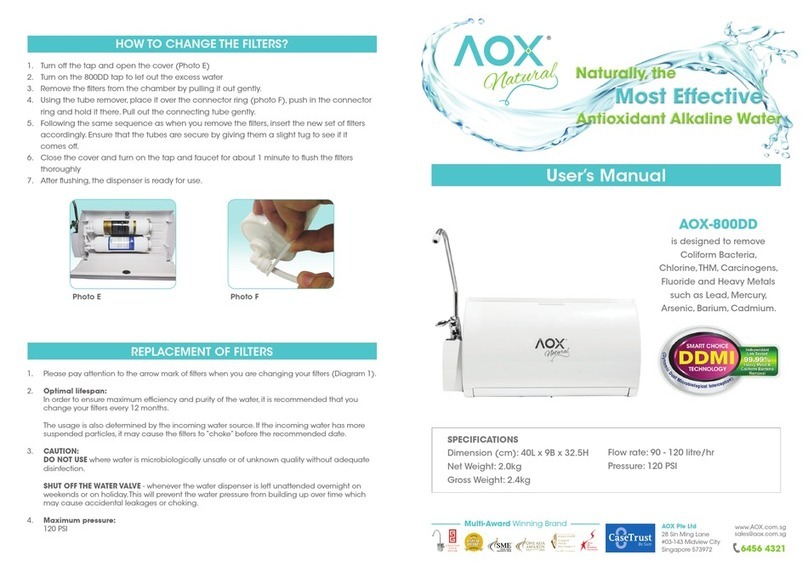cleanAIR 50 00 48 User manual

Personal respiratory protection systems
Canister filters - User manual
EN Operating instructions
DE Gebrauchsanweisung
FR Mode d’emploi
RU Руководство по эксплуатации
ES Instrucciones de uso
IT Istruzioni per l‘uso
FI Käyttöohje
SE Bruksanvisning
SI Navodila za uporabo
CZ Návod k použití
NA-038-R01



1.Instructions
•Make sure that all filters used are new and intact.
•If the air purifying unit is fitted with more than one filter, all filters used at the same time must be the same type (a set
of two / three identical filters).
Filters can only be used if the following rules are, or have been, observed:
•The user must be aware of the nature of contamination and the level of concentration in the ambient air.
•Oxygen concentration in the ambient air in the premises where the unit is used must not drop below 17 percent.
•The air purifying unit must not be used in confined spaces, e.g. enclosed containers, tunnels, channels, etc.
•Warning: high concentration of vapours that are heavier than air can occur at low height above the ground.
•If any of the conditions mentioned herein is not met, a self-contained oxygen breathing apparatus must be used (i.e.
one with an oxygen bottle).
•Filters the purpose of which is to filter out solid and liquid particles do not protect users from the exposure to gases.
•Gas filters do not provide any protection against particles.
•In case of contamination of working environment by both gas and particles it is necessary to use the combined filters.
•Special regulations must be observed in case of contamination by gases that are hard to identify.
•Filters need to be replaced whenever you feel any change in the odour of the air supplied by the unit.
•Only certified and original filters that are intended for use in your CleanAIR filtration unit can be used.
•Expired filters must not be used. The expiry date is indicated on each filter.
•Be careful when working in an environment where open flame or flying hot particles are present. The filter may catch
fire and the wearer’s life can be in danger!
•Filters that filter out mercury (Hg) must not be used for more than 50 hours!
WARNING! In case of any breach of proper filter use principles the warranty shall cease to exist!
2.Canister type filters – 50 00 ..; 50 01 ..; 50 02 ..; 50 03 .., 56 00 ...
Standard canister type filters with the RD 40x1/7“ thread pursuant to standard EN 148-1 are suitable for use along with
the air purifying units CleanAIR®Chemical, Chemical 3F or 2F. All filters used in the unit at the same time must be of the
same type.
Canister type filter replacement:
Remove the filter by unscrewing counter-clockwise. WARNING! Before you install new filters, make sure they are new
and intact and in their original packaging and that their usable-life period has not expired (as indicated on the body of
each filter). You must also make sure the gasket in the connection between the filters and the unit is intact. It is necessary
to make sure the unit is fully fastened, so as to provide tightness. If a pre-filter is used (50 01 10), affix it to the body of
the filter using a plastic holder (50 01 09) that is simply pushed onto the upper part.
In case of any doubts regarding the nature of work environment contamination, it is recommended that combined filters
be used. Before filter replacement, familiarize yourself with the operating instructions for the piece of equipment or
headpiece onto which the filter is installed.
Special rules must be observed when using combined filters the purpose of which is to filter out hazardous
radioactive particles.
For filter replacement demonstration, see figures 1A – 1C, filter for the CA Asbest 4A - 4B
3. Combined filter for the CA Pressure Conditioner unit
This powered air purifying station contains a combined filter (61 00 10) against dust, solid particles and aerosols. The
filter removes toxic solids and gases from industrial compressed air.
Read the operating instructions before use and filter replacement.
Up to two employees using the CleanAIR Pressure units can be connected to one filter station.
Filter replacement:
•Unscrew the upper part of the filter station (6 screws).
•Remove the contaminated filter and wipe out the inside of the container.
•Inspect the condition of the rubber gasket in the cap. If it is damaged, install a new one.
•Install the new filter onto the container cap and reinstall the upper part.
•Inspect the container, making sure it is airtight.
For filter replacement demonstration, see figures 2A – 2C
EN

4.CA Basic 2000 unit filter
The CA Basic air purifying unit is fitted with a highly effective filter that filters out P, R and SL class particles.
The level of filter clogging must be inspected on a regular basis.
The length of use depends on the level of contamination of the premises where the filter is used, as well as on the size
of the particles present. Due to personal hygiene concerns it is recommended that the maximum period of use should
not exceed 180 working hours.
Filters must not be cleaned or blown through in any way!
Unpleasant odours can be filtered out by using a special odour filter (80 00 20). If combined with a pre-filter (80 00 15),
the filter useful life can be prolonged significantly.
Filter replacement
•Remove the silver filter cover by placing your index fingers into the slots between the cover and the unit body.
•Press your thumbs against the upper part of the cover and gently push the cover away from the unit with your index
fingers. ATTENTION! Absolutely no tools allowed.
•Remove the filter by turning and pulling upwards.
•Remove dust from the unit.
•If an odour filter or pre-filter is used, affix it/them onto the new filter. Fasten it/them around the filter with the adhesive
tape that is a part of the pre-filter / odour filter.
•Insert the filter back into the unit by turning; press gently so that the filter can fit it precisely.
•Reinstall the filter cover, making sure the two clips on the sides fit into the body of the unit.
For filter replacement demonstration, see figures 3A – 3C
5.Filter selection based on the nature of air pollution
CleanAIR filters are marked pursuant to standards EN 14387+A1, EN 12 941/A2 and EN 12 942/A2.
Filters have the RD40x1/7“ thread pursuant to standard EN 148-1.
Ref.
no. Filter
type Related
standards
A-brown
B-grey
E-yellow
K-green
P-white
Hg-red
SX-purple
Filter with
a lead-in thread
Gas filters
Lightweight
combined filters
Heavyweight
combined filters
Note:
50 00 48 P R
EN 143 /
12941/A2,12942/A2
x -
56 00 10 P R SL, CA
Asbestos EN 143 /
12941/A2,12942/A2 x Only with “CA Asbest”units
80 00 10
P R SL
EN12941
x
Only with “CA Basic 2000”units
50 01 56 A2
EN 141 /
12941/A2,12942/A2
x x Does not filter out CO!
50 01 57 A2P R
EN 14387+A1, EN
12941/A2,12942/A2
x x x Does not filter out CO!
50 01 58 A2B2
EN 14387+A1,
12941/A2,12942/A2
x x x Does not filter out CO!
50 01 59 K2
EN 14387+A1,
12941/A2,12942/A2
x x Does not filter out CO!
50 01 60 K2P R
EN 14387+A1,
12941/A2,12942/A2
x x x Does not filter out CO!
50 01 61 B2
EN 14387+A1,
12941/A2,12942/A2
x x Does not filter out CO!
50 01 62 B2P R
EN 14387+A1,
12941/A2,12942/A2
x x x Does not filter out CO!
50 01 63 ABE2
EN 14387+A1,
12941/A2,12942/A2
x x x x Does not filter out CO!
50 01 64 ABE2P R
EN 14387+A1,
12941/A2,12942/A2
x x x x x Does not filter out CO!
50 01 65 NBC EN 12 942:1998 x x x x x x
Bojové otravné látky (Sarin, Soman,
Chlorpikrin). Does not filter out CO!

50 01 66 ABEK2HgP R
EN 14387+A1,
12941/A2,12942/A2
x x x x x x x Does not filter out CO!
50 01 67 AB2P R
EN 14387+A1,
12941/A2,12942/A2
x x x x Does not filter out CO!
50 01 68 ABEK2P R
EN 14387+A1,
12941/A2,12942/A2
x x x x x x Does not filter out CO!
50 01 69 ABEK2
EN 14387+A1,
12941/A2,12942/A2
x x x x x Does not filter out CO!
50 01 73
ABE2SXP R-
Ozone
EN 14387+A1,
12941/A2,12942/A2
x x x x x x
Does not filter out CO!
Filters out ozone.
50 02 48 P R
EN 14387+A1,
12941/A2,12942/A2
x x -
50 02 57 A2P R
EN 14387+A1, EN
12941/A2,12942/A2
x x x x Does not filter out CO!
50 02 68 ABEK2P R
EN 14387+A1,
12941/A2,12942/A2
x x x x x x x Does not filter out CO!
50 03 57
A1P R
EN 12941/A2,12942/A2
x
x
x
Does not filter out CO!
50 03 64
ABE1P R
EN 12941/A2,12942/A2
x
x
x
x
x
Does not filter out CO!
Basic types of gases:A– organic gases and vapours (boiling point > 65°C) P- solid and liquid aerosols
B– inorganic gases and vapours Hg - mercury
E– sulphur dioxide and acid gases and vapours SX – special filters for the particular gas
K– ammonia and organic amines
6.Storage and disposal
Filters may only be stored in premises where humidity is 0 - 95% Rh and where temperature ranges between
-10 °C and 55 °C.
The storage premises may not be contaminated by harmful substances. The period of storage in an intact packaging is
indicated by a pictogram on each filter. Upon opening, the filter may not be used for more than six months.
Only companies that are duly authorised to waste disposal of class 15 02 02 wastes may dispose the filters. Occupational
health and safety regulations must be observed during the process of filter disposal.
7.Warranty
Customers are granted a 12-month warranty period with respect to manufacturing defects. This period shall commence
on the day of sale. Claims must be raised with the actual vendor. Customers must present their receipt (invoice or delivery
note).
Said warranty shall not apply, inter alia, to defects caused by delayed filter replacement or by the use of a filter that has
previously been damaged by cleaning or blowing.
Notified person for CE testing: Výzkumný ústav bezpečnosti práce, v.v.i. - ZL
(Occupational Safety Research Institute)
Zkušební laboratoř č. 1024
Jeruzalémská 9, 116 52 Prague 1
Authorised body number 235
Notified body number 1024
Symbol with the number of the laboratory that
carried out testing
Storage conditions – TEMPERATURE
Read operating instructions before use! Storage conditions – HUMIDITY

1. Hinweise
•Vergewissern Sie sich, dass lediglich neue und unversehrte Filter benutzt werden.
•Falls die Gebläsefiltereinheit mit mehr als einem Filter ausgestattet ist, müssen jeweils Filter von gleichem Typ benutzt
werden (ein Satz von zwei / drei gleichen Filtern).
Die Filter dürfen nur unter der Voraussetzung benutzt werden, dass folgende Regeln eingehalten werden:
•Der Nutzer muss die Art der Kontamination und deren Konzentration in der Umluft wissen.
•Die Sauerstoffkonzentration in der Umgebung des Arbeiters, der die Gebläsefiltereinheit benutzt, darf nicht unter 17 %
sinken.
•Die Gebläsefiltereinheit darf nicht in geschlossenen Räumen, wie z. B. in geschlossenen Behältern, Tunneln, Kanälen
usw., benutzt werden.
•Achtung: Die Dämpfe, die schwerer als Luft sind, können sich niedrig über dem Boden in höheren Konzentrationen
befinden.
•Falls jegliche der oben angeführten Bedingungen verletzt wird, muss ein Isoliergerät (Sauerstoffflasche) benutzt
werden.
•Die zum Auffangen von festen und flüssigen Partikeln bestimmten Filter (Partikelfilter) schützen den Nutzer gegen
keine Gase.
•Die Gasfilter, die zum Auffangen von Gasen bestimmt sind, schützen den Nutzer gegen keine Partikeln.
•In einer Arbeitsumwelt, die durch beide Verunreinigungsarten (Gase sowie Partikeln) kontaminiert wurde, ist eine
Benutzung von Kombinationsfiltern erforderlich.
•Bei schwierig identifizierbaren Gassorten muss man besondere Regeln einhalten.
•Wechseln Sie die Filter jedes Mal, wenn Sie eine Änderung des Geruchs der aus der Einheit kommenden Luft spüren.
•Benutzen Sie lediglich die zertifizierten originalen Filter, die für Ihre Filtereinheit CleanAIR bestimmt sind.
•Die Filter dürfen nach dem abgelaufenen Haltbarkeitsdatum nicht benutzt werden. Jeder Filter ist mit dem
Haltbarkeitsdatum versehen.
•Vorsicht bei Arbeit an Stellen, wo es offenes Feuer oder abspringende glühende Partikeln gibt. Es kann zur
Entflammung des Filters und Bedrohung des Arbeiters kommen!
•Benutzen Sie den Filter gegen Hg (Quecksilber) nicht länger als 50 Stunden!
WARNUNG! Bei Verletzung von irgendeinem Grundsatz der Filterbenutzung wird die Garantie erlöschen!
2. Kanister - Filter – 50 00 ..; 50 01 ..; 50 02 ..; 50 03 .., 56 00 ...
Die üblichen Kanister-Filter mit dem Gewinde RD 40x1/7“ gemäß der EN 148-1 sind für den Gebrauch mit der
Gebläsefiltereinheit CleanAIR®Chemical, Chemical 3F oder 2F geeignet. Die Einheit muss immer mit den Filtern
gleichen Typs bestückt werden.
Wechsel eines Kanister-Filters:
Eine Demontage wird durch das Abschrauben des Filters entgegen dem Uhrzeigersinn durchgeführt.
VORSICHT! Vor der Montage der neuen Filter vergewissern Sie sich, dass die neuen Filter unversehrt, in einer originalen
Verpackung und mit einem nicht abgelaufenen Haltbarkeitsdatum (das direkt am Körper des Filters markiert ist) sind.
Weiter überprüfen Sie, ob die Dichtung an der Verbindungsstelle zwischen den Filtern und der Filtereinheit unversehrt
und in Ordnung ist. Es ist erforderlich, auf ein ordentliches Nachziehen zur Sicherung der Dichtheit der Verbindung zu
achten. Falls ein Vorfilter (50 01 10) benutzt wird, befestigen Sie ihn mit Hilfe vom Kunststoffhalter (50 01 09) an den
Körper des Filters durch ein einfaches Aufsetzen auf den oberen Teil.
Falls es irgendwelche Zweifel an der Kontaminationsart der Arbeitsumwelt gibt, wird es empfohlen, Kombinationsfilter zu
benutzen. Beim Filterwechsel lesen Sie auch die Anweisungen für den Gebrauch des Geräts oder der Schutzmaske
durch, an die der Filter angeschlossen wird.
Beim Gebrauch von Kombinationsfiltern, die gegen gefährliche radioaktive Partikeln benutzt werden, sind
besondere Regeln einzuhalten.
Die Vorgehensweise bei Filterwechsel ist in der Bildanlage unter 1A – 1C, filter der Einheit CA Asbest 4A - 4B
3. Kombinationsfilter der Einheit CA Pressure Conditioner
Die Druckluft-Filtereinheit beinhaltet einen Kombinationsfilter (61 00 10) gegen Staub sowie gegen feste Partikeln und
Aerosole. Der Filter beseitigt feste und gasförmige toxische Stoffe aus der industriell hergestellten Druckluft.
Bei Gebrauch und Wechsel lesen Sie die Gebrauchsanweisung.
Es können bis zu zwei Arbeiter mit der Einheit CleanAIR Pressure an einen Filter angeschlossen sein.
Filterwechsel:
•Schrauben Sie den oberen Teil des Druckbehälters des Filters (6 Schrauben) ab.
•Nehmen Sie den verunreinigten Filter heraus, wischen Sie das Innere des Behälters.
•Überprüfen Sie den Zustand der Gummidichtung im Deckel. Falls die Dichtung beschädigt ist, wechseln Sie sie.
DE

•Setzen Sie den neuen Filter auf den Deckel des Behälters und schrauben Sie wieder den oberen Teil auf.
•Überprüfen Sie die Dichtheit des Behälters.
Die Vorgehensweise bei Filterwechsel ist in der Bildanlage unter 2A – 2C.
4. Filter der Einheit CA Basic 2000
Die Gebläsefiltereinheit CA Basic beinhaltet einen hocheffektiven Filter gegen die Partikeln der Klasse P R SL.
Die Filterverstopfung ist regelmäßig zu überprüfen.
Die Filtergebrauchsdauer ist von der Kontaminationsstufe der Umgebung, in der er benutzt wird, und von der Größe der
Partikeln abhängig. Aus hygienischen Gründen beträgt die maximale empfohlene Gebrauchsdauer 180 Arbeitsstunden.
Es ist verboten, den Filter auf irgendeine Art und Weise zu reinigen oder durchzublasen!
Zur Beseitigung der unerwünschten Gerüche kann ein spezieller Filtereinsatz gegen Geruch (80 00 20) benutzt werden.
In Kombination mit einem Vorfilter (80 00 15) kann man so die Filtergebrauchsdauer deutlich verlängern.
Filterwechsel
•Entfernen des silbernen Filterdeckels: Stecken Sie die Zeigefinger in die Löcher zwischen dem Deckel und dem
Körper der Einheit.
•Stützen Sie ihre Daumen in den oberen Teil des Deckels und gleichzeitig nehmen Sie den Deckel mit den
Zeigefingern vorsichtig von der Einheit heraus. VORSICHT! Es ist streng verboten, welches auch immer Werkzeug
zu benutzen.
•Nehmen Sie den Filter mit einer Drehbewegung nach oben heraus.
•Wischen Sie den Staub an der Einheit.
•Falls ein Filtereinsatz gegen Geruch oder ein Vorfilter benutzt wird, befestigen Sie sie an den neuen Filter. Befestigen
Sie sie um den Filter herum mit Hilfe eines Klebebandes, das ein Bestandteil des Vorfilters/Filters gegen Geruch ist.
•Legen Sie den Filter mit einer gleichen Drehbewegung in die Einheit ein und drücken Sie ihn vorsichtig, bis er genau
aufgesetzt ist.
•Decken Sie den Filter mit dem Deckel zu und achten Sie darauf, dass beide Seitenclips in den Körper der Einheit
einschnappen.
Die Vorgehensweise bei Filterwechsel ist in der Bildanlage unter 3A – 3C.
5. Die Wahl eines Filters entsprechend den Schadstoffen in der Umwelt
Die Filter für CleanAIR sind gemäß den Normen EN 14387+A1, EN 12 941/A2 und EN 12 942/A2 bezeichnet.
Die Filter haben das Anschlussgewinde RD40x1/7“ gemäß EN 148-1.
Bestell-
nummer Filtertyp Entsprechende
Normen
A-braun
B-grau
E-gelb
K-grün
P-weiß
Hg-rot
SX-violett
Filter mit einem
Eingangsgewinde
Gasfilter
Leichte
Kombinationsfilter
Schwere
Kombinationsfilter
Bemerkungen:
50 00 48 P R
EN 143 /
12941/A2,12942/A2
x -
56 00 10
P R SL, CA
Asbest
EN 143 /
12941/A2,12942/A2
x Nur zur Einheit CA Asbest
80 00 10
P R SL
EN12941
x
Nur zur Einheit CA Basic 2000
50 01 56 A2
EN 141 /
12941/A2,12942/A2
x x Beseitigt das CO nicht!
50 01 57 A2P R
EN 14387+A1, EN
12941/A2,12942/A2
x x x Beseitigt das CO nicht!
50 01 58 A2B2
EN 14387+A1,
12941/A2,12942/A2
x x x Beseitigt das CO nicht!
50 01 59 K2
EN 14387+A1,
12941/A2,12942/A2
x x Beseitigt das CO nicht!

50 01 60 K2P R
EN 14387+A1,
12941/A2,12942/A2
x x x Beseitigt das CO nicht!
50 01 61 B2
EN 14387+A1,
12941/A2,12942/A2
x x Beseitigt das CO nicht!
50 01 62 B2P R
EN 14387+A1,
12941/A2,12942/A2
x x x Beseitigt das CO nicht!
50 01 63 ABE2
EN 14387+A1,
12941/A2,12942/A2
x x x x Beseitigt das CO nicht!
50 01 64 ABE2P R
EN 14387+A1,
12941/A2,12942/A2
x x x x x Beseitigt das CO nicht!
50 01 65 NBC EN 12 942:1998 x x x x x x
Chemische Kampfstoffe (Sarin,
Soman, Chlorpikrin). Beseitigt das
CO nicht!
50 01 66 ABEK2HgP R
EN 14387+A1,
12941/A2,12942/A2
x x x x x x x Beseitigt das CO nicht!
50 01 67 AB2P R
EN 14387+A1,
12941/A2,12942/A2
x x x x Beseitigt das CO nicht!
50 01 68 ABEK2P R
EN 14387+A1,
12941/A2,12942/A2
x x x x x x Beseitigt das CO nicht!
50 01 69 ABEK2
EN 14387+A1,
12941/A2,12942/A2
x x x x x Beseitigt das CO nicht!
50 01 73
ABE2SXP R-
Ozon
EN 14387+A1,
12941/A2,12942/A2
x x x x x x
Beseitigt das CO nicht! Beseitigt
das Ozon.
50 02 48 P R
EN 14387+A1,
12941/A2,12942/A2
x x -
50 02 57 A2P R
EN 14387+A1, EN
12941/A2,12942/A2
x x x x Beseitigt das CO nicht!
50 02 68 ABEK2P R
EN 14387+A1,
12941/A2,12942/A2
x x x x x x x Beseitigt das CO nicht!
50 03 57
A1P R
EN 12941/A2,12942/A2
x
x
x
Beseitigt das CO nicht!
50 03 64
ABE1P R
EN 12941/A2,12942/A2
x
x
x
x
x
Beseitigt das CO nicht!
Grundlegende Gasgruppen: A– Organische Gase und Dämpfe mit Siedepunkt über 65°C P- Aerosole mit festen und flüssigen Partikeln
B– Anorganische Gase und Dämpfe Hg - Quecksilber
E– Schwefeldioxid und saure Gase und Dämpfe SX – spezielle für das gegebene Gas bestimmte Filter
K- Ammoniak a organische Amine
6. Lagerung und Entsorgung
Die Filter müssen in Räumen mit einer Feuchtigkeit 0 - 95% RH und einer Temperatur im Bereich von -10 bis 55 °C
gelagert werden.
Der Lagerraum darf nicht mit Schadstoffen kontaminiert sein. Die Lagerdauer in einer unversehrten Verpackung ist an
jedem Filter mit einem Piktogramm angeführt. Nach dem Öffnen darf der Filter höchstens 6 Monate benutzt werden.
Die Entsorgung der Filter darf nur von einer spezialisierten Firma durchgeführt werden, die berechtigt ist, mit den Abfällen
der Klasse 15 02 02 umzugehen und bei ihrer Entsorgung müssen die Vorschriften des Gesundheits- und
Arbeitsschutzes eingehalten werden.
7. Garantie
Es wird eine Garantie auf die Fertigungsmängel für 12 Monate ab Verkauf an den Kunden gewährt. Die Reklamation
muss beim Verkäufer erhoben werden. Dabei muss ein Verkaufsnachweis (eine Rechnung oder ein Lieferschein)
vorgelegt werden.
Die Garantie bezieht sich vor allem auf die Mängel nicht, die durch einen nicht rechtzeitigen Filterwechsel oder durch
Gebrauch eines Filters entstanden sind, der durch Reinigung und Durchblasen beschädigt wurde.
Notifizierte Stelle fürs Überprüfen von CE: Výzkumný ústav bezpečnosti práce, v.v.i. – ZL
(Forschungsinstitut für Arbeitsschutz, öffentliches Forschungsinstitut – Prüflaboratorium)
Zkušební laboratoř č. 1024 (Prüflaboratorium Nr. 1024)
Jeruzalémská 9, 116 52 Prag 1
Autorisierte Person 235
Notifizierte Person 1024
Symbol mit der Nummer des Laboratoriums, das die
Überprüfung durchführte
Lagerbedingungen – TEMPERATUR
Vor Gebrauch lesen Sie die Gebrauchsanweisung! Lagerbedingungen – FEUCHTIGKEIT

1. Instructions
•Assurez-vous d’utiliser uniquement des filtres neufs et en bon état.
•Si l’unité de filtration à ventilation est équipée de plus d’un filtre, il faut toujours utiliser des filtres d’un même type. (jeu
de deux/trois filtres identiques)
Les filtres ne peuvent être utilisés qu’à condition de respecter les règles suivantes :
•L’utilisateur doit connaître le type de contamination et sa concentration dans l’air ambiant.
•La concentration d’oxygène autour du travailleur utilisant l’unité de filtration à ventilation doit rester supérieure à 17 %.
•L’unité de filtration à ventilation ne doit pas être utilisée dans des espaces confinés tels que p. ex. des réservoirs
fermés, des tunnels, des canalisations, etc.
•Mise en garde : au niveau du sol, on peut trouver des concentrations élevées d’émanations plus lourdes que l’air.
•Si l’une quelconque de ces conditions n’est pas respectée, il faut utiliser un appareil respiratoire isolant (bouteille
d’oxygène).
•Les filtres destinés à retenir les particules solides et liquides (filtres à particules) ne protègent l’utilisateur contre aucun
gaz.
•Les filtres à gaz destinés à retenir les gaz ne protègent l’utilisateur contre aucune particule.
•Dans les environnements de travail contaminés par les deux types de pollution (gaz et particules), il faut utiliser des
filtres combinés.
•Pour les types de gaz difficilement identifiables, il faut respecter des règles spéciales.
•Changez les filtres à chaque fois que vous sentez un changement dans l’air provenant de l’unité.
•Utilisez uniquement des filtres d’origine, certifiés pour votre unité de filtration CleanAIR.
•Il ne faut pas utiliser de filtres dont la date d’expiration est échue. Cette date est indiquée sur chaque filtre.
•Attention lors du travail à des endroits où se trouvent une flamme nue ou des particules incandescentes volantes. Le
filtre peut s’enflammer et mettre en péril le travailleur !
•En cas d’utilisation contre le plomb (Hg), ne pas utiliser le filtre plus de 50 heures !
MISE EN GARDE ! Toute violation d’un principe d’utilisation du filtre mènera à l’annulation de la garantie !
2. Cartouches de filtre – 50 00 ..; 50 01 ..; 50 02 ..; 50 03 .., 56 00 ...
Les cartouches de filtre standardisées à filetage RD 40x1/7“, conformes à la norme EN 148-1, conviennent à une
utilisation avec les unités de filtration à ventilation CleanAIR®Chemical, Chemical 3F ou 2F. L’unité doit toujours être
équipée de filtres d’un même type.
Remplacement de la cartouche de filtre :
Le démontage est réalisé en dévissant le filtre dans le sens contraire des aiguilles d’une montre.
ATTENTION ! Avant de monter de nouveaux filtres, assurez-vous que ces nouveaux filtres ne sont pas endommagés,
qu’ils sont dans leur emballage d’origine et que leur durée d’utilisation n’est pas échue (elle est indiquée directement sur
le filtre). Contrôlez également que le joint entre le filtre et l’unité de filtration ne soit pas endommagé et soit en bon état.
Il faut bien visser le filtre pour assurer l’étanchéité du joint. Si vous utilisez un pré-filtre (50 01 10), installez-le sur le filtre
au moyen de son support de matière plastique (50 01 09) en l’enfilant simplement sur sa partie supérieure.
Au moindre doute sur le type de contamination de l’environnement de travail, il est recommandé d’utiliser des filtres
combinés. Lors du remplacement des filtres, prenez également connaissance du mode d’emploi de l’appareil ou du
masque de protection auquel le filtre est branché.
Il faut respecter des règles spéciales pour l’utilisation de filtres combinés contre les particules radioactives
dangereuses.
Le procédé de remplacement des filtres est illustré par les figures 1A à 1C, pour l’unité CA Amiante 4A - 4B
3. Filtre combiné pour l’unité CA Pressure Conditioner
Cette unité de purification d’air comprimé comporte un filtre combiné (61 00 10) contre la poussière et contre les
particules solides et les aérosols. Le filtre élimine les matières toxiques solides et gazeuses de l’air comprimé produit
industriellement.
Pour son utilisation et son remplacement, lisez le mode d’emploi.
Jusqu’à deux travailleurs équipés d’une unité CleanAIR Pressure peuvent se connecter sur un même purificateur.
Remplacement du filtre :
•Dévissez la partie supérieure du récipient sous pression du purificateur (6 vis).
•Retirez le filtre usagé, essuyez l’intérieur du récipient.
•Contrôlez l’état du joint de caoutchouc du couvercle. Si le joint est endommagé, remplacez-le.
•Installez le nouveau filtre sur le couvercle du récipient et revissez la pièce supérieure.
FR

•Contrôlez l’étanchéité du récipient.
Le procédé de remplacement des filtres est illustré par les figures 2A à 2C
4. Filtre de l’unité CA Basic 2000
L’unité de filtration à ventilation CA Basic comporte un filtre à haute efficacité contre les particules de classes P, R, SL.
Il faut régulièrement contrôler l’encrassage du filtre.
La durée d’utilisation du filtre dépend du degré de contamination du milieu dans lequel il est utilisé et de la taille des
particules. Pour des raisons d’hygiène, la durée d’utilisation maximale recommandée est de 180 heures de travail.
Il est interdit de laver le filtre ou de le nettoyer par soufflage de quelque manière que ce soit !
Pour éliminer les mauvaises odeurs indésirables, il est possible d’utiliser un insert spécial pour odeurs (80 00 20).
Combiné au pré-filtre (80 00 15), il permet de prolonger significativement la durée de vie du filtre.
Remplacement du filtre
•Retrait du couvercle argenté du filtre : Enfilez les index dans les ouvertures entre le couvercle et le corps de l’unité.
•Appuyez avec les pouces sur la partie supérieure du couvercle tout en retirant doucement le couvercle avec les
index. ATTENTION ! Il est strictement interdit d’utiliser un quelconque outil.
•Retirez le filtre d’un mouvement rotatif en tirant vers le haut.
•Nettoyez la poussière de l’unité.
•En cas d’utilisation d’un filtre à odeurs ou d’un pré-filtre, fixez-le sur le nouveau filtre. Fixez-le autour du filtre au
moyen de la bande adhésive fournie avec le pré-filtre/filtre à odeurs.
•Avec le même mouvement de rotation, insérez le filtre dans l’unité et appuyez légèrement jusqu’à ce qu’il soit bien
en place.
•Placez le couvercle sur le filtre en veillant à ce que les agrafes latérales soient correctement en place sur le corps
de l’unité.
Le procédé de remplacement des filtres est illustré par les figures 3A à 3C
5. Choix du filtre en fonction des produits nocifs dans l’air
Les filtres CleanAIR portent des marquages conformes aux normes EN 14387+A1, EN 12 941/A2 et EN 12 942/A2.
Les filtres sont dotés d’un filetage de fixation RD40x1/7“ conformément à la norme EN 148-1.
N°
de réf. Type
de filtre Conformité
aux normes
A-Marron
B-Gris
E-Jaune
K-Vert
P-Blanc
Hg-Rouge
SX-Violet
Filtre à filetage
d’entrée
Filtres anti-gaz
Filtres légers
combinés
Filtres lourds
combinés
Notes :
50 00 48 P R
EN 143 /
12941/A2,12942/A2
x -
56 00 10
P R SL, CA
Asbest
(amiante)
EN 143 /
12941/A2,12942/A2 x Uniquement pour l’unité CA Asbest
80 00 10 P R SL EN12941 x
Uniquement pour l’unité CA Basic
2000
50 01 56 A2
EN 141 /
12941/A2,12942/A2
x x N’élimine pas le CO !
50 01 57 A2P R
EN 14387+A1, EN
12941/A2,12942/A2
x x x N’élimine pas le CO !
50 01 58 A2B2
EN 14387+A1,
12941/A2,12942/A2
x x x N’élimine pas le CO !
50 01 59 K2
EN 14387+A1,
12941/A2,12942/A2
x x N’élimine pas le CO !
50 01 60 K2P R
EN 14387+A1,
12941/A2,12942/A2
x x x N’élimine pas le CO !
50 01 61 B2
EN 14387+A1,
12941/A2,12942/A2
x x N’élimine pas le CO !
50 01 62 B2P R
EN 14387+A1,
12941/A2,12942/A2
x x x N’élimine pas le CO !

50 01 63 ABE2
EN 14387+A1,
12941/A2,12942/A2
x x x x N’élimine pas le CO !
50 01 64 ABE2P R
EN 14387+A1,
12941/A2,12942/A2
x x x x x N’élimine pas le CO !
50 01 65 NBC EN 12 942:1998 x x x x x x
Armes chimiques (Sarin, Soman,
Chloropicrine). N’élimine pas le
CO !
50 01 66 ABEK2HgP R
EN 14387+A1,
12941/A2,12942/A2
x x x x x x x N’élimine pas le CO !
50 01 67 AB2P R
EN 14387+A1,
12941/A2,12942/A2
x x x x N’élimine pas le CO !
50 01 68 ABEK2P R
EN 14387+A1,
12941/A2,12942/A2
x x x x x x N’élimine pas le CO !
50 01 69 ABEK2
EN 14387+A1,
12941/A2,12942/A2
x x x x x N’élimine pas le CO !
50 01 73
ABE2SXP R-
Ozone
EN 14387+A1,
12941/A2,12942/A2
x x x x x x
N’élimine pas le CO ! Élimine
l’ozone.
50 02 48 P R
EN 14387+A1,
12941/A2,12942/A2
x x -
50 02 57 A2P R
EN 14387+A1, EN
12941/A2,12942/A2
x x x x N’élimine pas le CO !
50 02 68 ABEK2P R
EN 14387+A1,
12941/A2,12942/A2
x x x x x x x N’élimine pas le CO !
50 03 57
A1P R
EN 12941/A2,12942/A2
x
x
x
N’élimine pas le CO !
50 03 64
ABE1P R
EN 12941/A2,12942/A2
x
x
x
x
x
N’élimine pas le CO !
Groupes de gaz de base : A– gaz et vapeurs organiques à point d’ébullition > 65°C P– aérosols solides et liquides
B– gaz et vapeurs anorganiques Hg – mercure
E– dioxyde de soufre et gaz et vapeurs acides SX – filtres spéciaux destinés à un gaz donné
K– ammoniaque et amines organiques
6. Stockage et élimination
Les filtres doivent être stockés dans des locaux présentant une humidité relative entre 0 et 95% et une température entre
-10 et 55 °C.
Les locaux de stockage ne doivent pas être contaminés par des produits nocifs. La durée de stockage dans l’emballage
intact est indiquée par un pictogramme sur chaque filtre. Après ouverture, le filtre peut être utilisé pendant 6 mois au
maximum.
L’élimination des filtres ne peut être réalisée que par une entreprise spécialisée autorisée à traiter des déchets de la
classe 15 02 02, et lors de leur élimination il faut respecter les règlements de sécurité et de protection de la santé au
travail.
7. Garantie
Une garantie de 12 mois après la date de vente au client est fournie pour les défauts de fabrication. Les réclamations
doivent être effectuées auprès du vendeur. Il faut présenter un document d’achat (facture ou bordereau de livraison).
La garantie ne s’applique pas aux défauts causés par un remplacement tardif du filtre ou par l’utilisation d’un filtre
endommagé par un lavage ou un soufflage.
Organisme notifié pour les tests CE : Výzkumný ústav bezpečnosti práce, v.v.i.
(Institut de recherche sur la sécurité du travail)
Zkušební laboratoř č. 1024
(Laboratoire d’essais)
Jeruzalémská 9, 116 52 Prague 1
Organisme agréé 235
Organisme notifié 1024
Symbole accompagné du numéro du laboratoire
ayant réalisé les vérifications
Conditions de stockage – TEMPÉRATURE
Lire le mode d’emploi avant l’utilisation ! Conditions de stockage – HUMIDITÉ

1.Инструкции
•Убедитесь, что используются только новые и неповрежденные фильтры.
•Если фильтро-вентиляционный агрегат укомплектован более чем одним фильтром, должны всегда
использоваться фильтры одного типа. (набор из двух / трех одинаковых фильтров)
Фильтры должны использоваться только при условии, что соблюдены следующие правила:
•Пользователь должен знать тип загрязнения и его концентрацию в окружающем воздухе.
•Концентрация кислорода поблизости работника, использующего фильтро-вентиляционный агрегат, не
должна опуститься ниже 17 %.
•Фильтро-вентиляционный агрегат не должен использоваться в закрытых пространствах, как например:
закрытые резервуары, тоннели, каналы и т.д.
•Предупреждение: испарения, которые тяжелее воздуха, могут находиться в любых концентрациях низко над
землей.
•Если любое из указанных условий нарушено, необходимо использовать изоляционный дыхательный прибор
(кислородный баллон).
•Фильтры, предназначенные для улавливания твердых и жидких частиц (фильтры для устранения частиц), не
защищают пользователя от газов.
•Противогазовые фильтры, предназначенные для улавливания газов, не защищают пользователя от каких-
либо частиц.
•В рабочей среде, загрязненной обоими типами загрязнения (газы и частицы), необходимо использовать
комбинированные фильтры.
•Для сложно идентифицируемых типов газов необходимо соблюдать специальные правила.
•Заменяйте фильтр каждый раз, когда почувствуете изменение запаха воздуха, выходящего из агрегата
очистки.
•Применяйте только сертифицированные оригинальные фильтры, предназначенные для Вашего
фильтрационного агрегата CleanAIR.
•Фильтры с просроченным сроком годности использовать запрещено. Дата обозначена на каждом фильтре.
•Внимание при работе на местах, где находится открытый источник огня либо вылетающие искры. Может
наступить возгорание фильтра и тем самым поставить под угрозу работника!
•При использовании против Hg (ртути), не использовать более 50 часов!
ПРЕДУПРЕЖДЕНИЕ! При нарушении каких-либо инструкций при использовании фильтра гарантия
прекращается!
2. Канистровые фильтры – 50 00 ..; 50 01 ..; 50 02 ..; 50 03 .., 56 00 ...
Стандартные канистровые фильтры с резьбой RD 40x1/7“ согласно EN 148-1 пригодны для использования
сфильтро-вентиляционным агрегатом CleanAIR®Chemical, Chemical 3F либо 2F. Агрегат должен быть всегда
укомплектован фильтрами одного типа.
Замена канистрового фильтра:
Демонтаж осуществляется путем откручивания фильтра против часовой стрелки.
ВНИМАНИЕ! Перед установкой новых фильтров убедитесь, что новые фильтры не повреждены, они
воригинальной упаковке с не просроченным сроком годности (срок годности указан прямо на корпусе фильтра).
Также проверьте, что уплотнение в месте соединения фильтра с фильтрационным агрегатом не нарушено и не
повреждено. Необходимо уделить внимание надлежащему затягиванию, для достижения уплотненности
соединения. Если используется предварительный фильтр (50 01 10), закрепите его на корпусе фильтра с
помощью пластмассового держателя (50 01 09), просто надвинув его на верхнюю часть.
Если имеются какие-либо сомнения в типе загрязнения рабочей среды, рекомендуется использовать
комбинированные фильтры. При замене фильтров ознакомьтесь с руководством по эксплуатации прибора либо
защитной маски, на которой фильтр закреплен.
При использовании комбинированных фильтров, используемых против опасных радиоактивных
частиц, необходимо соблюдать специальные правила.
Действия по замене фильтров указаны в наглядной части 1A – 1C, фильтр агрегата CA Asbest 4A - 4B
3. Комбинированный фильтр агрегата CA Pressure Conditioner
Чистящий агрегат сжатого воздуха содержит комбинированный фильтр (61 00 10) против пыли, твердых частиц
и аэрозолей. Фильтр устраняет твердые и газовые токсичные вещества из промышленно производимого сжатого
воздуха.
При использовании и замене читайте руководство по эксплуатации.
На один очиститель может быть подключено до двух работников с агрегатом CleanAIR Pressure.
RU

Замена фильтра:
•Открутите верхнюю часть очистителя высокого давления (6 болтов).
•Удалите загрязненный фильтр, резервуар вытрите внутри.
•Проконтролируйте состояние резинового уплотнения в крышке. Если уплотнение повреждено, замените
его.
•Установите новый фильтр на крышку и прикрутите обратно верхнюю часть.
•Проверьте уплотнение резервуара.
Действия по замене фильтра указаны в наглядной части 2A – 2C
4. Фильтр агрегата CA Basic 2000
Фильтро-вентиляционный агрегат CA Basic содержит высокоэффективный фильтр против частиц класса P R SL.
Загрязнение фильтра необходимо регулярно контролировать.
Срок службы фильтра зависит от степени загрязнения окружающего пространства, а также от размера самых
частиц. По санитарным причинам максимальный срок использования составляет 180 рабочих часов.
Запрещено чистить фильтр каким-либо способом или продувать!
Для устранения нежелательного запаха можно использовать специальную вставку (80 00 20). В комбинации
спредварительным фильтром (80 00 15) можно значительно продлить срок службы самого фильтра.
Замена фильтра
•Снять серебряную крышку фильтра: Вставьте указательные пальцы в отверстия между крышкой и корпусом
агрегата.
•Упереться пальцами в верхнюю часть крышки и одновременно указательными пальцами вытащите крышку
в направлении от агрегата очистки. ВНИМАНИЕ! Запрещено использовать какие-либо инструменты.
•Фильтр вытащите поворотным движением в направлении вверх.
•Очистите агрегат от пыли.
•Если используется фильтр против запаха либо предварительный фильтр, прикрепите их на новый фильтр.
Закрепите его около фильтра с помощью липкой ленты, которая является составной частью
предварительного/против запаха фильтра.
•Вставьте фильтр таким же вращательным движением в агрегат и слегка придавите, пока точно не сядет на
место.
•Закройте фильтр крышкой и следите за тем, чтобы клипсы по сторонам точно сели в корпус агрегата.
Действия по замене фильтра указаны в наглядной части 3A – 3C
5. Выбор фильтра согласно вредных веществ в воздухе
Фильтры для CleanAIR обозначены согласно нормам EN 14387+A1, EN 12 941/A2 a EN 12 942/A2.
Фильтры имеют присоединительную резьбу RD40x1/7“ согласно EN 148-1.
№
заказа Тип
фильтра
Соответствующие
нормы
A-
Коричневая
B-Серая
E-Желтая
K-Зеленая
P-Белая
Hg-Красная
SX-
Фиолетовая
Фильтр с входной
резьбой
Противогазовый
фильтр
Легко
комбинированный
фильтр
Тяжело
комбинированный
фильтр
Примечания:
50 00 48 P R
EN 143 /
12941/A2,12942/A2
x -
56 00 10
P R SL, CA
Asbest
EN 143 /
12941/A2,12942/A2
x Только к агрегату CA Asbest
80 00 10
P R SL
EN12941
x
Только к агрегату CA Basic 2000

50 01 56 A2
EN 141 /
12941/A2,12942/A2
x x Не удаляет CO!
50 01 57 A2P R
EN 14387+A1, EN
12941/A2,12942/A2
x x x Не удаляет CO!
50 01 58 A2B2
EN 14387+A1,
12941/A2,12942/A2
x x x Не удаляет CO!
50 01 59 K2
EN 14387+A1,
12941/A2,12942/A2
x x Не удаляет CO!
50 01 60 K2P R
EN 14387+A1,
12941/A2,12942/A2
x x x Не удаляет CO!
50 01 61 B2
EN 14387+A1,
12941/A2,12942/A2
x x Не удаляет CO!
50 01 62 B2P R
EN 14387+A1,
12941/A2,12942/A2
x x x Не удаляет CO!
50 01 63 ABE2
EN 14387+A1,
12941/A2,12942/A2
x x x x Не удаляет CO!
50 01 64 ABE2P R
EN 14387+A1,
12941/A2,12942/A2
x x x x x Не удаляет CO!
50 01 65 NBC EN 12 942:1998 x x x x x x
Боевые отравляющие вещества
(Зарин, Зоман, Хлорпикрин). Не
удаляет CO!
50 01 66 ABEK2HgP R
EN 14387+A1,
12941/A2,12942/A2
x x x x x x x Не удаляет CO!
50 01 67 AB2P R
EN 14387+A1,
12941/A2,12942/A2
x x x x Не удаляет CO!
50 01 68 ABEK2P R
EN 14387+A1,
12941/A2,12942/A2
x x x x x x Не удаляет CO!
50 01 69 ABEK2
EN 14387+A1,
12941/A2,12942/A2
x x x x x Не удаляет CO!
50 01 73
ABE2SXP R-
Ozon
EN 14387+A1,
12941/A2,12942/A2
x x x x x x Не удаляет CO! Устраняет озон.
50 02 48 P R
EN 14387+A1,
12941/A2,12942/A2
x x -
50 02 57 A2P R
EN 14387+A1, EN
12941/A2,12942/A2
x x x x Не удаляет CO!
50 02 68 ABEK2P R
EN 14387+A1,
12941/A2,12942/A2
x x x x x x x Не удаляет CO!
50 03 57
A1P R
EN 12941/A2,12942/A2
x
x
x
Не удаляет CO!
50 03 64 ABE1P R
EN 14387+A1, EN
12941/A2,12942/A2
x x x x x Не удаляет CO!
Основные группы газов: A– органические газы и пары с точкой кипения > 65°C P– твердые и жидкие аэрозоли
B– неорганические газы и пары Hg – ртуть
E– двуокись серы, кислые газы и пары SX – специальные фильтры, предназначенные для
K– аммиак и органические амины данного газа
6. Хранение и ликвидация
Фильтры должны храниться в помещениях с влажностью 0 – 95 % Rh и температурой в диапазоне от -10 до 55°C.
Помещение склада не должно быть загрязнено вредными веществами. Срок хранения в ненарушенной упаковке
указан в пиктограмме на каждом фильтре. После вскрытия фильтр должен быть использован в течение 6
месяцев.
Ликвидацию фильтров может осуществлять только специализированная фирма, имеющая право осуществлять
утилизацию отходов класса 15 02 02, а при их ликвидации необходимо соблюдать предписания по безопасности
и охране здоровья при работах.
7. Гарантия
На производственные дефекты предоставляется гарантия 12 месяцев с момента продажи заказчику.
Рекламация подается в магазин организации. При этом необходимо представить документ о продаже (фактуру
либо накладную).
Гарантия не распространяется на дефекты, возникшие в связи с несвоевременной заменой фильтра либо
всвязи с использованием фильтра поврежденного очисткой и продувкой.
Нотифицированное лицо для тестирования CE: Výzkumný ústav bezpečnosti práce, v.v.i. – ZL
(Исследовательский институт безопасности труда – ЗЛ)
Zkušební laboratoř č. 1024
Jeruzalémská 9, 116 52 Praha 1
Авторизованное лицо 235
Нотифицированное лицо 1024
Символ с номером лаборатории, которая
проводила экспертизу
Условия хранения – ТЕМПЕРАТУРА
Перед использованием прочтите руководство! Условия хранения – ВЛАЖНОСТЬ

1. Instrucciones
•Asegúrese de que solamente son usados filtros nuevos e intactos
•Si la unidad de filtro-ventilación posee más de un filtro, siempre deben ser usados filtros de un mismo tipo. (set de
dos/tres filtros iguales)
Los filtros pueden ser usados solo bajo el supuesto de que se cumplen las siguientes reglas:
•El usuario debe conocer el tipo de contaminación y su concentración en el aire circundante.
•La concentración de oxigeno alrededor del trabajador que usa la unidad de filtro-ventilación no debe caer por debajo
del 17%.
•La unidad de filtro-ventilación no debe ser usada dentro de lugares cerrados, como son por ejemplo: depósitos
cerrados, túneles, canales, etc.
•Atención: los vapores más pesados que el aire pueden encontrarse cerca del suelo en mayores concentraciones.
•Si cualquiera de las condiciones arriba mencionadas han sido violadas, debe ser usado una máquina aislante de
respiración (bomba de oxígeno).
•Los filtros diseñados para la captación de partículas sólidas o líquidas (filtros contra partículas) no protegen al usuario
contra ningún tipo de gas.
•Los filtros contra gas diseñados para la captación de gases no protegen al usuario contra ningún tipo de partícula.
•En los ambientes laborales que están contaminados con ambos tipos de contaminación (gases y partículas) es
necesario usar filtros combinados.
•Para tipos de gases difíciles de identificar es necesario cumplir con normas especiales.
•Cambien los filtros cada vez que sienta un cambio en el olor del aire que proviene de la unidad.
•Utilice solo los filtros originales certificados que han sido diseñados para su unidad de filtración CleanAIR.
•Los filtros que han pasado el tiempo de expiración no deben ser utilizados. La fecha se indica en cada filtro.
•¡Cuidado al trabajar en lugares en donde hay fuego abierto o partículas inflamables suspendidas en el aire. El filtro
se puede inflamar y se pone así en peligro al trabajador!.
•¡Cuando se usa ante Hg (mercurio) no usar el filtro más allá de 50 horas!.
ATENCIÓN! La garantía expira por el incumplimiento de cualquiera de las normas de uso del filtro
2. Filtros de bidón– 50 00 ..; 50 01 ..; 50 02 ..; 50 03 .., 56 00 ...
Los filtros de bidón con rosca RD 40x1/7” según EN 148-1” están aptos para el uso con la unidad de filtro-ventilación
CleanAIR®Chemical, Chemical 3F o 2F. La unidad debe ser usada siempre con filtros del mismo tipo.
Cambio del filtro de bidón:
El desmontaje se realiza desatornillando el filtro en sentido en contra de las agujas del reloj.
¡ATENCIÓN! Antes del montaje de nuevos filtros, asegúrese de que los nuevos filtros no están dañados, se encuentran
en su embalaje original y dentro del tiempo apto para su uso (está indicado directamente sobre el cuerpo del filtro).
Además, revise que el ajustamiento en el lugar de unión entre los filtros y la unidad de filtración no esté dañado y se
encuentre en orden. Es necesario prestar atención a la debida apretura para garantizar la hermeticidad de la unión. Si
se utiliza un prefiltro (50 01 10), asegúrelo al cuerpo del filtro con la ayuda del sujetador de plástico
(50 01 09) con un simple ajuste a la parte superior.
En caso de cualquier duda sobre el tipo de contaminación existente en el ambiente laboral, se recomienda el uso de
filtros combinados. Cuando cambie los filtros, familiarícese también con las instrucciones de uso del equipo o de las
máscaras protectoras a las que está unido el filtro.
Durante el uso de filtros combinados usados ante partículas radiactivas peligrosas es necesario cumplir con
normas especiales.
El procedimiento para el cambio de los filtros en la sección de imágenes 1A - 1C, filtro de la unidad CA Asbest 4A - 4B
3. Filtro combinado de la unidad CA Pressure Conditioner
La unidad de limpieza de aire a presión se compone de un filtro combinado (61 00 10) contra el polvo y partículas sólidas
y aerosoles. El filtro elimina sustancias tóxicas sólidas y gaseosas del aire a presión fabricado industrialmente.
Lea las instrucciones de uso antes de usar y cambiar.
Hasta dos trabajadores pueden estar conectados a un limpiador con la unidad CleanAIR Pressure
Cambio del filtro:
•Desatornille la parte superior del recipiente a presión del limpiador (6 tornillos).
•Cambie el filtro sucio, limpie el recipiente desde adentro.
•Revise el estado del ajustamiento de goma de la tapa. Si el ajustamiento estuviera dañado, cámbielo.
•Ajuste el nuevo filtro a la tapa del recipiente y atornille de nuevo la pieza superior.
•Revise que quede ajustado el recipiente.
ES

El procedimiento para el cambio de los filtros en la sección de imágenes 2A - 2C
4. Filtro de la unidad CA Basic 2000
La unidad de filtro-ventilación CA Basic contiene un filtro altamente efectivo ante partículas de clase P R SL.
Es necesario revisar regularmente el ajuste del filtro.
El tiempo de uso del filtro depende del grado de contaminación del ambiente circundante en el cual se utiliza y del
tamaño de las partículas. Por razones higiénicas se recomienda como tiempo máximo de uso 180 horas laborales.
¡Queda prohibido limpiar el filtro de cualquier modo o aventar!
Para la eliminación de olores indeseables se puede usar una plantilla especial para olores (80 00 20). En combinación
con un prefiltro (80 00 15) es posible alargar significativamente la vida del filtro.
Cambio del filtro
•Quitar la tapa plateada del filtro: introduzca los dedos índices en los orificios entre la tapa y el cuerpo de la unidad.
•Ponga el dedo pulgar sobre la parte superior de la tapa y al mismo tiempo con los dedos índices extraiga la tapa en
dirección hacia fuera de la unidad. ¡ATENCIÓN! Está terminantemente prohibido usar cualquier instrumento.
•Retire el filtro con un movimiento rotatorio en dirección hacia arriba.
•Limpie el polvo de la unidad.
•Si se utiliza un filtro de olores o prefiltro, ajústelo al nuevo filtro. Asegúrelo alrededor del filtro con la cinta adhesiva,
que forma parte del empaque.
•Introduzca el filtro con el mismo movimiento rotatorio hacia la unidad y suavemente presione hasta que encaje de
forma precisa.
•Cubra el filtro con la tapa y observe que ambos clips coincidan con el cuerpo de la unidad.
El procedimiento de cambio de filtros se encuentra en la sección de imágenes 3A-3C
5. Selección del filtro según los agentes nocivos presentes en el aire.
Los filtros para CleanAIR han sido señalados según las normas EN 14387+A1, EN 12 941/A2 a EN 12 942/A2.
Los filtros poseen una rosca de unión RD40x1/7“ según EN 148-1.
No. de
objeto Tipo de
filtro Norma
correspondiente
A - Marrón
B - Gris
E - Amarillo
K - Verde
P - Blanco
Hg - Rojo
SX - Morado
Filtro con rosca
de
entrada
Filtros antigas
Filtros ligeros
combinados
Filtros pesados
combinados
Observaciones:
50 00 48 P R
EN 143 /
12941/A2,12942/A2
x -
56 00 10
P R SL, CA
Asbest
EN 143 /
12941/A2,12942/A2
x Solo para la unidad CA Amianto
80 00 10
P R SL
EN12941
x
Solo para la unidad CA Basic 2000
50 01 56 A2
EN 141 /
12941/A2,12942/A2
x x ¡No elimina el CO!
50 01 57 A2P R
EN 14387+A1, EN
12941/A2,12942/A2
x x x ¡No elimina el CO!
50 01 58 A2B2
EN 14387+A1,
12941/A2,12942/A2
x x x ¡No elimina el CO!
50 01 59 K2
EN 14387+A1,
12941/A2,12942/A2
x x ¡No elimina el CO!
50 01 60 K2P R
EN 14387+A1,
12941/A2,12942/A2
x x x ¡No elimina el CO!
50 01 61 B2
EN 14387+A1,
12941/A2,12942/A2
x x ¡No elimina el CO!
50 01 62 B2P R
EN 14387+A1,
12941/A2,12942/A2
x x x ¡No elimina el CO!
50 01 63 ABE2
EN 14387+A1,
12941/A2,12942/A2
x x x x ¡No elimina el CO!
50 01 64 ABE2P R
EN 14387+A1,
12941/A2,12942/A2
x x x x x ¡No elimina el CO!

50 01 65 NBC EN 12 942:1998 x x x x x x
Sustancias venenosas con fines
bélicos (Sarín, Soman,
Cloropicrina).
¡No elimina el CO!
50 01 66 ABEK2HgP R
EN 14387+A1,
12941/A2,12942/A2
x x x x x x x ¡No elimina el CO!
50 01 67 AB2P R
EN 14387+A1,
12941/A2,12942/A2
x x x x ¡No elimina el CO!
50 01 68 ABEK2P R
EN 14387+A1,
12941/A2,12942/A2
x x x x x x ¡No elimina el CO!
50 01 69 ABEK2
EN 14387+A1,
12941/A2,12942/A2
x x x x x ¡No elimina el CO!
50 01 73
ABE2SXP R-
Ozon
EN 14387+A1,
12941/A2,12942/A2
x x x x x x
¡No elimina el CO!
¡No elimina el ozono!
50 02 48 P R
EN 14387+A1,
12941/A2,12942/A2
x x -
50 02 57 A2P R
EN 14387+A1, EN
12941/A2,12942/A2
x x x x ¡No elimina el CO!
50 02 68 ABEK2P R
EN 14387+A1,
12941/A2,12942/A2
x x x x x x x ¡No elimina el CO!
50 03 57
A1P R
EN 12941/A2,12942/A2
x
x
x
¡No elimina el CO!
50 03 64
ABE1P R
EN 12941/A2,12942/A2
x
x
x
x
x
¡No elimina el CO!
Grupos básicos de gases: A- gases orgánicos y vapores con punto de ebullición > 65°C P- aerosoles líquidos y sólidos
B- gases y vapores inorgánicos Hg - mercurio
E- oxido de sulfuro y gases y vapores ácidos SX - filtros especiales diseñados para un gas
K- amoniaco y aminas orgánicas determinado
6. Almacenamiento y liquidación
Los filtros deben ser almacenados en lugares con humedad de entre 0 y 95% y temperatura en el rango de -10 hasta
55 ºC.
El lugar de almacenamiento no debe estar contaminado con agentes nocivos. El tiempo de almacenamiento en el
empaque sellado está indicado en cada filtro con un pictograma. El filtro puede ser usado un máximo de 6 meses
después de ser abierto.
La liquidación de los filtros debe ser hecha solamente por compañías especializadas y competentes para el manejo de
residuos de clase 15 02 02, y durante su liquidación es necesario cumplir con los reglamentos para la seguridad
y protección de la salud en lugares de trabajo.
7. Garantía
Para los defectos de fabricación se brinda una garantía de 12 meses a partir del día de venta al cliente. Es necesario
hacer efectiva la reclamación en la organización expedidora. Al mismo tiempo, es necesario mostrar el comprobante de
compra (factura o recibo de entrega).
La garantía no se aplica principalmente a los defectos producto del cambio tardío del filtro o el uso de filtros dañados
o aventados.
Persona notificada para el testado CE: Výzkumný ústav bezpečnosti práce, v.v.i. - ZL
(Instituto de Investigaciones en seguridad laboral, v.v.i-ZL)
Zkušební laboratoř č. 1024
Jeruzalémská 9, 116 52 Praga 1
Persona autorizada 235
Persona notificada 1024
Símbolo con el número del laboratorio que llevó a
cabo el testado
Condiciones de almacenamiento - TEMPERATURA
¡Lea las instrucciones antes de usar! Condiciones de almacenamiento - HUMEDAD

1. Istruzioni
•Assicuratevi che vengano utilizzati esclusivamente dei filtri nuovi e non deteriorati.
•Se l’unità di filtraggio e di ventilazione viene equipaggiata con più di un filtro debbono essere sempre usati filtri dello
stesso tipo. (set di due / tre filtri uguali)
I filtri possono essere utilizzati soltanto a condizione che vengano osservate le seguenti regole:
•L’utente è tenuto a conoscere la tipologia della contaminazione e la sua concentrazione presente nell’aria circostante.
•La concentrazione di ossigeno nelle vicinanze dell’operatore che utilizza l’unità di filtrazione e di ventilazione non deve
essere inferiore al 17%.
•L’unità di filtraggio e di ventilazione non deve venire usata in spazi chiusi come, ad esempio, serbatoi chiusi, tunnel,
canalizzazioni e così via.
•Avvertenza: le esalazioni più pesanti dell’aria si possono trovare in concentrazioni maggiori a bassa altezza da terra.
•Qualora qualsiasi dalle condizioni riportate qui sopra venisse violata deve essere utilizzato un autorespiratore di
isolamento (bombola ad ossigeno).
•I filtri destinati alla cattura di particelle solide e liquide (filtri anti-particolato) non proteggono l’utilizzatore da alcun tipo
di sostanze gassose.
•I filtri antigas destinati a catturare le sostanze gassose non proteggono l’utilizzatore da alcun tipo di particolato e da
polveri sottili.
•In un ambiente di lavoro contaminato da entrambi di tipi di sostanze contaminanti (gas e particelle di polvere) è
necessario usare i filtri combinati.
•Per quanto riguarda i tipi di gas di difficile identificazione occorre osservare della regole speciali.
•I filtri vanno sostituiti ogni volta che sentite il cambiamento di odore dell’aria proveniente dall’unità.
•Utilizzate esclusivamente i filtri originali certificati destinati alla vostra unità di filtrazione CleanAIR.
•I filtri giunti al termine della durata di utilizzo non possono più essere utilizzati. La data della durata viene segnata su
ogni filtro.
•State attenti durante le operazioni di lavoro nei luoghi in cui c’è il fuoco vivo oppure dove volano le particelle
incandescenti. Può verificarsi l’accensione del filtro con possibili danni alla salute dell’operatore!
•Il filtro anti-Hg (mercurio) non deve essere utilizzato per un periodo maggiore di 50 ore!
AVVISO! La violazione di qualsiasi istruzione d’uso del filtro comporta la cessazione della rispettiva garanzia!
2. Filtri a bidone – 50 00 ..; 50 01 ..; 50 02 ..; 50 03 .., 56 00 ...
Filtri standard a bidone con filettatura RD 40x1/7“ secondo le EN 148-1 sono adatti per l’uso assieme all’unità di filtraggio
e di ventilazione CleanAIR®Chemical, Chemical 3F nebo 2F. L’unità deve essere sempre equipaggiata con filtri dello
stesso tipo.
Sostituzione di un filtro a bidone:
Lo smontaggio viene effettuato allentando il filtro nel senso antiorario. AVVERTENZA: Prima del montaggio dei filtri nuovi
bisogna accertarsi che i nuovi filtri siano integri e che si trovino nel loro imballo originale e la loro validità non sia scaduta
(la scadenza viene sempre indicata direttamente sul corpo del filtro). Inoltre occorre controllare
che la tenuta delle congiunzioni dei filtri con l’unità di filtraggio non sia alterata e sia in ordine. Bisogna fare attenzione al
loro corretto serraggio al fine di garantire la giusta tenuta della giunzione. Nel caso in cui venga usato un filtro preliminare
(50 01 10), esso deve essere fissato al corpo del filtro tramite un supporto di plastica (50 01 09) infilandolo semplicemente
sulla parte superiore.
Se dovesse sorgere qualsiasi dubbio riguardo il tipo di contaminazione dell’ambiente di lavoro si consiglia di utilizzare i
filtri combinati. Per la sostituzione dei filtri consultate anche le istruzioni d’uso dell’apparecchio oppure della maschera
protettiva alla quale il filtro viene installato.
Per l’uso di filtri combinati utilizzati contro le pericolose particelle radioattive è necessario osservare delle regole
speciali.
Il procedimento per la sostituzione dei filtri è descritto nella parte illustrata 1A – 1C, filtro dell’unità CA Asbest 4A - 4B
3. Il filtro combinato dell’unità CA Pressure Conditioner
L’unità di purificazione dell’aria compressa contiene un filtro combinato (61 00 10) contro particelle di polvere e contro
particelle solide e aerosol. Il filtro rimuove le sostanze solide e gassose tossiche dall’aria compressa prodotto su scala
industriale.
Durante l’utilizzo e la sostituzione consultate sempre le istruzioni per l’uso.
Su un depuratore possono essere collegati fino a due operatori equipaggiati con l’unità CleanAIR Pressure.
Sostituzione del filtro:
•Rimuovete le viti della parte superiore del recipiente a pressione del depuratore (6 viti).
•Estraete il filtro otturato, pulite l’interno del recipiente con un panno.
IT

•Verificate lo stato della guarnizione in gomma del coperchio. Se la guarnizione è danneggiata, sostituitela.
•Il filtro nuovo va infilato sul coperchio del recipiente. Riavvitate il pezzo superiore.
•Controllate lo stato di tenuta del recipiente.
Il procedimento della sostituzione dei filtri nella parte illustrata 2A – 2C.
4. Il filtro dell’unità CA Basic 2000
L’unità di filtraggio e di ventilazione CA Basic è munita di un filtro altamente efficace contro il particolato della classe P
R SL.
Lo stato di otturazione del filtro va regolarmente controllato.
Il periodo di utilizzo del filtro dipende dal livello di contaminazione dell’ambiente circostante nel quale esso viene utilizzato
e dalla grandezza delle particelle. La durata massima consigliata di utilizzo è limitata, per motivi igienici, a 180 ore
lavorative.
E’ vietato in qualsiasi modo pulire o spurgare il filtro!
Al fine di rimuovere odori non desiderati può essere usato una speciale cartuccia antiodore (80 00 20). Combinandola
con un filtro preventivo (80 00 15) può aumentare di gran lunga la durata dell’uso del filtro.
Sostituzione del filtro
•Come togliere il coperchio argentato del filtro: inserite gli indici delle mani nei fori tra il coperchio ed il corpo dell’unità.
•Appoggiate le dita nella parte superiore del coperchio ed, al tempo stesso, estraete dolcemente con l’aiuto degli
indici il coperchio fuori dall’unità. ATTENZIONE! E’ severamente vietato servirsi di qualsiasi strumento meccanico.
•Estraete il filtro con un movimento rotatorio verso l’alto.
•Pulite l’unità dalla polvere.
•Se vengono utilizzati un filtro antiodore oppure un filtro preventivo, fissate questi ultimi sul nuovo filtro. Fissatelo
attorno al filtro per mezzo di un nastro adesivo che fa parte del filtro preventivo/filtro-antiodore.
•Inserite il filtro dell’unità mediante lo stesso movimento rotativo premendolo leggermente finché esso non entri
precisamente nella sua sede.
•Coprite il filtro con il suo coperchio facendo attenzione che entrambe le clip laterali entrino bene nel corpo dell’unità.
Il procedimento della sostituzione dei filtri è indicato nella parte illustrata 3A – 3C.
5. La scelta del filtro a seconda del tipo di particelle contaminanti nell’atmosfera
I filtri per il CleanAIR sono contrassegnati in conformità alle norme EN 14387+A1, EN 12 941/A2 a EN 12 942/A2.
La filettatura di avvitamento dei filtri è del tipo RD40x1/7“ dle EN 148-1.
N° ordine
Tipo di filtro
Norme
corrispondenti
A-Marrone
B-Grigio
E-Giallo
K-Verde
P-Bianco
Hg-Rosso
SX-Viola
Filtro con
filettatura ingresso
Filtri antigas
Filtri leggeri
combinati
Filtri pesanti
combinati
Note:
50 00 48 P R
EN 143 /
12941/A2,12942/A2
x -
56 00 10
P R SL, CA
Amianto
EN 143 /
12941/A2,12942/A2
x Solo per l’unità CA Amianto
80 00 10
P R SL
EN12941
x
Solo per l’unità CA Basic 2000
50 01 56 A2
EN 141 /
12941/A2,12942/A2
x x Non rimuove il CO!
50 01 57 A2P R
EN 14387+A1, EN
12941/A2,12942/A2
x x x Non rimuove il CO!
50 01 58 A2B2
EN 14387+A1,
12941/A2,12942/A2
x x x Non rimuove il CO!
50 01 59 K2
EN 14387+A1,
12941/A2,12942/A2
x x Non rimuove il CO!
50 01 60 K2P R
EN 14387+A1,
12941/A2,12942/A2
x x x Non rimuove il CO!
This manual suits for next models
22
Table of contents
Languages:
